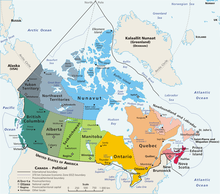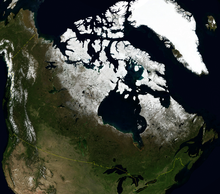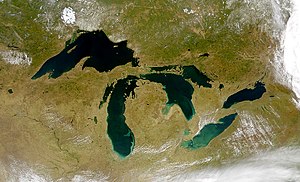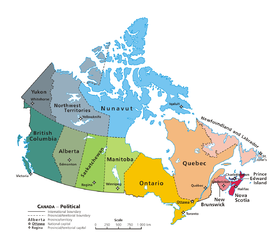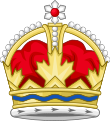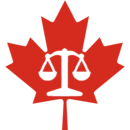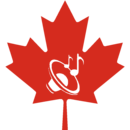Overview of and topical guide to Canada
The National Flag of Canada An enlargeable map of Canada , showing its ten provinces and three territories. The following outline is provided as an overview of and topical guide to Canada :
Canada () is a North American country consisting of ten provinces and three territories . Located in the northern part of the continent, it extends from the Atlantic Ocean in the east to the Pacific Ocean in the west and northward into the Arctic Ocean .[ 1] world's second largest country by total area, and shares land borders with the United States to the south and northwest, and marine borders with France and Greenland on the east and northeast, respectively.
The lands have been inhabited for millennia by various groups of aboriginal peoples . Beginning in the late 15th century, British and French expeditions explored and later settled the Atlantic coast. France ceded nearly all of its colonies in North America in 1763 after the Seven Years' War .
In 1867, with the union of three British North American colonies through Confederation , Canada was formed as a federal dominion of four provinces.[ 2] [ 3] [ 4] accretion of additional provinces and territories and a process of increasing autonomy from the United Kingdom , highlighted by the Statute of Westminster in 1931 and culminating in the Canada Act in 1982 which severed the vestiges of legal dependence on the British parliament.
Canada is a federation that is governed as a parliamentary democracy and a constitutional monarchy with King Charles III as its head of state. It is a bilingual and multicultural country, with both English and French as official languages at the federal level. Technologically advanced and industrialized , Canada maintains a diversified economy that is heavily reliant upon its abundant natural resources and upon trade—particularly with the United States, with which Canada has a long and complex relationship .
General reference
An enlargeable map of Canada
Geography
Geography of Canada
Canada is...
Location:
Northern Hemisphere , Western Hemisphere
Time zones (Time in Canada ):
Extreme points of Canada
North: Cape Columbia , Nunavut - (83°08' N, 74°13'W)
South: Middle Island , Ontario - (41°41'N, 82°40'W)
East: Cape Spear , Newfoundland - (47°31'N, 52°37'W)
West: Yukon-Alaska border - (141°00'W)
High: Mount Logan , Yukon 5,959 m (19,551 ft)
Low: North Atlantic Ocean , Arctic Ocean , and North Pacific Ocean 0 m Land boundaries: United States 8,893 km (5,526 miles)[ 5] Greenland 1,280 m (4,200 feet) (on Hans Island )
Environment
An enlargeable satellite image of Canada Environment of Canada
Geographic features
A satellite image of the Great Lakes.
Regions
Other regions
Ecoregions
Provinces and territories
Provinces and territories of Canada
Provinces
Province, with flag
Postal abbreviation/ISO code
Other abbreviations
Capital
Entered Confederation
Population[ 8]
Area (km2 )
Land
Water
Total
Ontario 1
ON
Ont.
Toronto
July 1, 1867
13,448,494
917,741
158,654
1,076,395
Quebec 1
QC
Que., PQ, P.Q.
Quebec City
8,164,361
1,356,128
185,928
1,542,056
Nova Scotia 2
NS
N.S.
Halifax
923,598
53,338
1,946
55,284
New Brunswick 2
NB
N.B.
Fredericton
747,101
71,450
1,458
72,908
Manitoba 3
MB
Man.
Winnipeg
July 15, 1870
1,278,365
553,556
94,241
647,797
British Columbia 2
BC
B.C.
Victoria
July 20, 1871
4,648,055
925,186
19,549
944,735
Prince Edward Island 2
PE
PEI, P.E.I., P.E. Island
Charlottetown
July 1, 1873
142,907
5,660
—
5,660
Saskatchewan 4
SK
Sask., SK, SKWN
Regina
September 1, 1905
1,098,352
591,670
59,366
651,036
Alberta 4
AB
Alta.
Edmonton
4,067,175
642,317
19,531
661,848
Newfoundland and Labrador 5
NL
Nfld., NF, LB
St. John's
March 31, 1949
519,716
373,872
31,340
405,212
Notes:
Immediately prior to Confederation, Ontario and Quebec were part of the Province of Canada .
Nova Scotia, New Brunswick, British Columbia, and Prince Edward Island were separate colonies at the time of joining Canada.
Manitoba was established simultaneously with Northwest Territories.
Saskatchewan and Alberta were created out of land that had been part of Northwest Territories.
Prior to its entry in Confederation, Newfoundland had been a Dominion within the British Commonwealth, but due to a financial crisis during the Depression had surrendered its right to self-government and was under direct British governance.
Territories
There are currently three territories in Canada. Unlike the provinces, the territories of Canada have no inherent jurisdiction and only have those powers delegated to them by the federal government.
Territory, with flag
Postal abbreviation/ISO code
Other abbreviations
Capital
Entered Confederation
Population[ 8]
Area (km2 )
Land
Water
Total
Northwest Territories
NT
N.W.T., NWT
Yellowknife
July 15, 1870
41,786
1,183,085
163,021
1,346,106
Yukon
YT
Y.T., YK
Whitehorse
June 13, 1898
35,874
474,391
8,052
482,443
Nunavut
NU
NV
Iqaluit
April 1, 1999
35,944
1,936,113
157,077
2,093,190
Note: Canada did not acquire any new land to create Yukon, Alberta, Saskatchewan, or Nunavut. All of these originally formed part of Northwest Territories.
Municipalities
Municipalities of Canada
Demography
Demography of Canada
Demographics by political division
Provinces
Territories
Government and politics
Politics of Canada
Branches of the government
Politics of Canada
Executive branch of the government
Government of Canada
Legislative branch of the government
Judicial branch of the government
Court system of Canada
Supreme Court of Canada Appellate Courts of the provinces and territories
Superior-level trial courts of the provinces and territories
Foreign relations
Foreign relations of Canada
International organization membership
Canada is a member of:[ 1]
Legal system
Law of Canada
Military
Military of Canada
Command structure
Canadian Forces
Canadian Coast Guard
Provincial governments
Territory governments
Politics by political division
Provinces
Territories
History
History of Canada by period
History of Canada by political division
Provinces
Territories
Culture
Culture of Canada
Culture by political division
Provinces
Territories
Art in Canada
Music
Music of Canada
Music by political division
Provinces
Territories
Religion in Canada
Sport in Canada
Sport in Canada
Official Sports
Other sports
Hall of Fame Museums
Economy and infrastructure
Economy of Canada
Economic rank, by nominal GDP (2007) : 9th (ninth)Agriculture in Canada Banking in Canada
Communications in Canada
Companies of Canada List of convention and exhibition centres Currency of Canada : Dollar
Economic history of Canada Energy in Canada
Health care in Canada
Mining in Canada Science and technology in Canada Stock exchanges:
Economics by political division
Provinces
Territories
Education in Canada
Education by political division
Provinces
Territories
Higher Education by political division
Provinces
Territories
Bibliographies
See also
References
^ a b "Canada" . The World Factbook United States Central Intelligence Agency . July 8, 2009. Retrieved July 23, 2009 .^ "Territorial evolution" . Atlas of Canada . Natural Resources Canada. Archived from the original on 2007-08-09. Retrieved 2007-10-09 . In 1867, the colonies of Canada, Nova Scotia and New Brunswick are united in a federal state, the Dominion of Canada.... ^ "Canada: History" . Country Profiles . Commonwealth Secretariat. Archived from the original on 2007-10-12. Retrieved 2007-10-09 . The British North America Act of 1867 brought together four British colonies ... in one federal Dominion under the name of Canada. ^ Hillmer, Norman; W. David MacIntyre. "Commonwealth" . Canadian Encyclopedia . Historica Project. Retrieved 2007-10-09 . With CONFEDERATION in 1867, Canada became the first federation in the British Empire ... ^ The total length of the land border between Canada and the United States is the longest between any two countries.
^ The coastline of Canada is the longest in the world. The total length of the coast of Canada is more than five times as long as the circumference of the Earth .
^ Government of Canada, Statistics Canada (December 15, 2022). "Census Profile, 2021 Census - Canada [Country]" . www12.statcan.gc.ca . Retrieved January 24, 2023 . ^ a b "Population and dwelling counts, for Canada, provinces and territories, 2016 and 2011 censuses – 100% data" . Statistics Canada. 8 February 2017. Retrieved July 17, 2020 .
External links
Government Crown corporations Other


